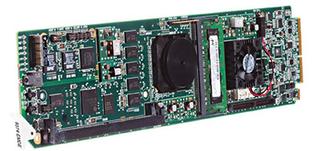Cobalt Eases HD Transition at Calvary Chapel

Cobalt Digital’s 9374 MADI embedder/de-embedder
FT. LAUDERDALE, FLA.—Calvary Chapel Fort Lauderdale is one of the nation’s largest and fastest-growing churches. It was founded in 1985 by Pastor Bob Coy and a handful of believers and has since grown to “mega” status, accommodating more than 20,000 people at services on the main campus in Fort Lauderdale, and reaching other members and worshippers at regional locations in Boca Raton, Boynton, the Florida Keys, Hollywood, Naples, North Lauderdale, Plantation, the Villages and West Boca Raton—all in Florida.
The worship service programming originates from the main campus in Ft. Lauderdale and reaches the nine remote campuses in a variety of ways, including fiber optic connectivity, file transfer, video streaming and even on such recordable media as Blu-ray and DVDs.
Not long ago a decision was made to upgrade video operations to high-definition, and as with most such projects, this one was accompanied by a host of issues that had to be addressed. Based on past experience we looked to Cobalt Digital for some of the solutions.
One of the first things we encountered in the HD transition proved to be a two-fold challenge. In an SD environment the three signals that comprise the production process—audio, video and timecode—are combined at the recorder. However, in an HD world these signals need to be combined (or embedded) before they reach ingest/playout devices such as video file servers, DVRs, and the like. Marrying audio and video wasn’t really a problem, but we had no way to add in the timecode element.
ADDING TIMECODE TO THE MIX
The second part of that challenge was the number of streams we needed to embed. We produce many different versions of the same material, and we need to embed 16 HD-SDI streams. While many companies can provide embedders and some offer dual embedders, Cobalt is one of the few manufacturers that make quad embedders, their 9374 MADI embedder/de-embedder product. This card was exactly what we were looking for. It seemed a bit costly at first, but when you calculate the total cost per stream, the 9374 works out as a very cost-effective solution and solved one of our problems. However there was still the issue of embedding timecode.
I approached Cobalt about developing a solution and they did! The 9374 now includes an option to insert timecode, thus eliminating the need for a second module.
ALL THIS AND MADI TOO
Another really invaluable aspect of the 9374 card is that it has—along with AES audio capability—a MADI interface with a 64-channel payload. The combination of timecode and MADI in a quad card designed to operate in the openGear frame is really brilliant. I’ll never again design a studio without incorporating this card. I also have to say that since the launching of the new HD facility, Cobalt Digital cards have performed absolutely flawlessly. We’re very impressed with the efforts of the whole Cobalt team and in their development of these highly functional cards.
John Groves has been involved in television production for 40 years and is currently a video systems engineer/systems integrator. He may be contacted ataudiographicseng@msn.com.
For additional information, contact Cobalt Digital at 800-669-1691 or visitwww.cobaltdigital.com.
Get the TV Tech Newsletter
The professional video industry's #1 source for news, trends and product and tech information. Sign up below.
